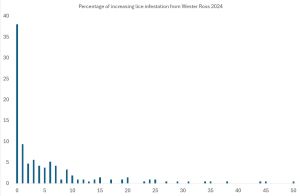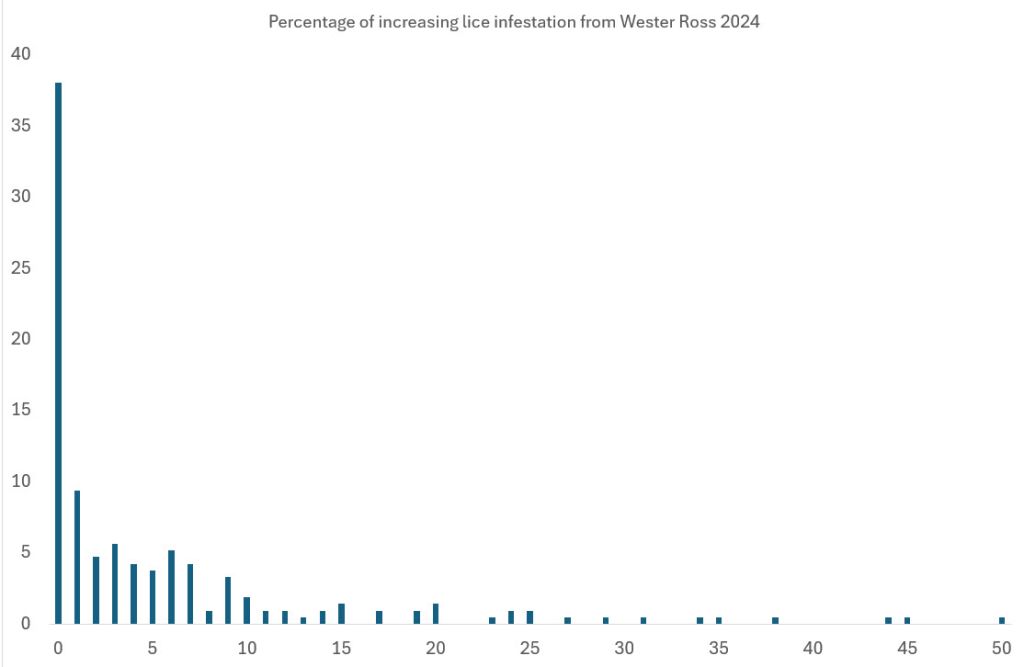Lice: Although it is now nearly six months since the sea lice monitoring programme for 2024 was completed, Fisheries Management Scotland have still to publish the results. I am sure they would be quick to complain if the salmon farming industry were slow to publish any of their data.
Whilst the Scottish data remains unavailable, the fishing reports for Wester Ross in Trout & Salmon magazine mentioned that Wester Ross Fisheries Trust (WRFT) have published their 2024 data on their website. The fishing report states that “small sea trout taken at the Kanaird in May 2024 were heavily lice -infested – concurring with reports from local anglers. Lice levels recorded on wild fish tend to correlate with reported lice abundance on nearby salmon farms. In 2024 the farm nearest the River Kanaird monitoring site reported weekly average sea lice counts of 1.4 per farmed fish from week 15 to week 22.”
What the fishing report doesn’t mention is that WRFT have published three reports Ardmair, Torridon, and Applecross in which they sample a total of 23 times, of which May 2024 at Kanaird is just one. All the other samplings record low lice counts.
It is important to point out that out of the 24 different samplings, only one meets the sea lice monitoring protocol of a minimum of 30 fish. The remaining samples range from just one fish (six of the samplings) to 29. In addition, three of the samplings caught no fish at all. The reality is that almost all these samplings are meaningless, because as they fail to meet the protocol they should be considered as invalid.
In May 2024, the sampling, which the fishing report refers to, at Kanaird caught a total of just 13 fish, eight of which were calculated to be classified as red using the Taranger formula. The others were green – 3, yellow – 1, and orange -1. Thus, whilst the fishing report refers to heavily liced fish, there were in fact only eight fish in total.
WRFT caught 211 fish across the three areas of which 10 fish were classified as red. This is just under 5%. 12 were classified as orange, 14 were yellow and the remaining 175 were classified as green. The graph showing the lice per fish as a percentage of the total is shown below. It is a classic aggregated distribution.

Trout and Salmon magazine might like to portray the lice situation around Kanaird as a problem with small sea trout taken from around the river as heavily lice -infested, but the reality is very different with less than 5% carrying larger numbers of lice, even with WRFT’s poor sampling. The problem is that, as soon as the wild fish sector see one fish carrying high numbers of lice, they automatically blame salmon farms, when a small number of fish with high lice counts is entirely natural.
Lice 2: This week, at least one Edinburg school sent out an email to parents advising that there had been a few cases of headlice in their community. More interestingly the email states:
The NHS advises that at any one time, it is estimated that 5% of a school’s population will have headlice,
This reflects what we see with sea lice, that the majority of hosts carry no sea lice at all and only a small number are infested.
NASF 1: Salmon Business published a number of stories emanating from the recent North Atlantic Seafood Forum (NASF) meeting in Bergen.
In a panel discussion, in a section titled ‘An Industry at Risk’ in a wider session about ‘Salmon Welfare in Aquaculture’, Krister Hoaas, Head of Farming for the Western Region of the Norwegian Seafood Federation stated that:
We are regulated on what is best for wild salmon, not on what is best for the fish in the pens.
I nearly agree with Mr Hoaas but my view is that the industry is regulated on what some ‘think’ is best for wild salmon, despite clear evidence that it is not. The plain fact is that the introduction of the Traffic Light regulation has done nothing to protect wild salmon in Norway. Wild salmon numbers are in decline and continue to be so irrespective of more stringent controls on salmon farming. The reason is simple, and despite claims by the Scientific Committee for Salmon Management that salmon farming is the biggest threat to wild salmon, salmon farming has little impact on wild fish numbers. The Norwegian Government continue to implement a regulation on salmon farming that has no real function because salmon farming is not the reason why wild salmon are so threatened.
The Norwegian Government is planning to encourage farms away from open net pens at a cost of billions of kroner, but this will have no impact on wild fish numbers at all.
I do agree with Mr Hoaas that the welfare of the fish in the pens should be given more consideration, and this should begin by removal of the need to treat fish when sea lice levels reach a set threshold. Treating farmed fish in the mistaken belief that wild fish will be protected is the consequence of regulation that has not been given proper consideration. This is not surprising because the regulation is based on the poor advice from a scientific community who don’t really understand wild salmon or wild salmon interactions.
NASF 2. The introduction to the Panel discussion, in which Krister Hoaas spoke, was made by Edgar Brun, Academic Director of Fish Health and Welfare at the Veterinary Institute. During his presentation, Dr Brun called out the industry’s self-righteousness, poor crisis management and reluctance to engage with critics.
Dr Brun continued that the aquaculture industry is an immature industry or one at least in its teenage years and by alluding to the industry’s earning, he added that ‘we all now how teens with a lot of money behave’.
Frankly, his statement is outrageous. I don’t think it is the salmon farming industry, which is misbehaving, but rather the scientists and regulators who fail to comprehend the business of salmon farming.
Undeterred, he then criticised the industry’s lobbying power and its dismissive approach to handling challenges. He said it has a low ability to listen and meet critics in a positive way. It might be a start if the critics would be more willing to engage in open discussion, rather than criticise from afar,
Dr Brun then attacked the industry ‘s supposed failure to react to sea lice pointing out that outbreaks follow predictable seasonal patterns, yet the response remains panicked and disorganised. He said that they react like it’s a surprise when the temperature increases. However, there is more to sea lice infestation than changing temperature.
Dr Brun also raised concerns over legal battles delaying action on health issues saying that ‘it seems that lawyers are on the highest risk factors for the spread of disease’.
Finally, he said that there is one narrative about the success of salmon farming and a second about disease and welfare. He said that we had this brilliant product and now the media is full of the opposite.
I believe that Dr Brun has failed to grasp the real issues surrounding fish health and welfare. The fact that mortality, welfare and reputation are all related, and they have been magnified by the failure of the various institutions to show any willingness to discuss them except amongst themselves. If salmon farmers feel the need to resort to legal recourse it is because of this refusal to engage. It is only necessary to look back at last week’s commentary to see the intransigence and it’s not on the part of the salmon farming industry.
NASF 3: The reputation of farmed salmon in Norway has been questioned over the past couple of years. The media machine has been working overtime on behalf of the wild salmon sector who blame salmon farming for the decline of wild salmon and have thus been keen to highlight issues such as mortality to the public.
In response, NASF invited the CEO of chicken producer Norsk Kylling to provide a candid account of the company’s journey from reputation crisis to industry leader in animal welfare and sustainability.
Hilde Talseth told the conference that the company had reached a low point ten years ago having been plagued by environmental scandals and poor animal welfare standards. Over the intervening years, the company has worked hard to make improvement by switching to slower growing breeds and offering invitations to animal welfare organisations to visit their farms. She said that the company’s transformation should serve as a model as to how radical transparency, collaboration and long-term think can turn a struggling business into a consumer favourite. It is a remarkable story; however, the company’s transformation is not the model for salmon farmers to follow because the causes of the loss of reputation are very different.
It seems that many of the issues causing Norsk Kylling to have a poor reputation were of their own making whilst the fall in salmon’s reputation is very much outside the industry’s control. As alluded to at the beginning of this commentary, the fundamental problem is the flawed belief by the wild salmon sector that salmon farming is the cause of all their ills. This belief is re-enforced by the clique of scientists who are unwilling to explore the science and find the truth.
The key to improving the reputation of farmed salmon is to engage in open discussion with both industry accusers and the scientific community as Edgar Brun recommends. I can only hope that he will set an example.
FMS conference: Whilst FMS have failed to update the sea lice monitoring data, it seems that they can update other sections of their website, Details of their 2025 conference have now been posted and this will take place on Friday 21st March.
The title of the conference is ‘Working in Partnership to Deliver Solutions’ which appears to be more management speak than offering the prospect of safeguarding the future of wild salmon.
Interestingly, although FMS spoke extensively to the RAIC inquiry about salmon farming and has the services of a paid for Interactions Manager, the conference programme is devoid of any mention of salmon farming.
The main theme appears to be restoration and how to attract funding to pay for it. However, as I have pointed out previously, habitat restoration is somewhat of a waste of time if wild salmon are failing to return to this restored habitat from their migration to the northern feeding grounds.
The conference will also hear about the Wild Salmon Connections meeting in London and ask what next?
Finally, the conference will end with a panel discussion led by Dr John Armstrong who is returning for a second visit to the conference in two years. Dr Armstrong is clearly more at home within the wild fish sector because he has certainly avoided all my attempts to talk to him about the alleged impacts of salmon farming.
Videos of the presentations should be eventually posted on the FMS website, and I look forward to discussing them in reLAKSation when they do.

